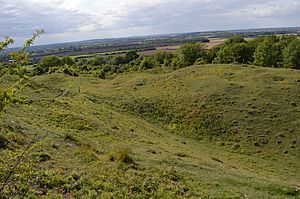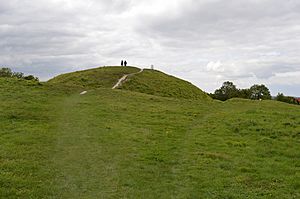Totternhoe Knolls facts for kids
| Site of Special Scientific Interest | |
 |
|
| Area of Search | Bedfordshire |
|---|---|
| Interest | Biological |
| Area | 13.1 hectares |
| Notification | 1985 |
| Location map | Magic Map |
Totternhoe Knolls is a really special place in Totternhoe, Bedfordshire, England. It's a big area, about 13.1 hectares, which is like 26 football fields! This amazing spot is known as a Site of Special Scientific Interest (SSSI) because it has unique plants and animals. It's also a local nature reserve, meaning it's protected for nature and people to enjoy. Totternhoe Knolls is part of the beautiful Chilterns Area of Outstanding Natural Beauty.
This land is owned by Central Bedfordshire Council. It is looked after by the National Trust and the Wildlife Trust for Bedfordshire, Cambridgeshire and Northamptonshire (WTBCN). It's part of the larger WTBCN Totternhoe nature reserve. This reserve also includes places like Totternhoe Chalk Quarry and Totternhoe Stone Pit. The SSSI also protects Totternhoe Castle, which is an ancient Norman castle site.
Contents
Exploring Totternhoe Knolls
Totternhoe Knolls is a fantastic place to discover nature and history. It's a protected area because of its special wildlife and important historical features.
A Place for Rare Plants
Part of Totternhoe Knolls used to be a quarry. Here, people mined a strong type of chalk called Totternhoe Stone. This stone was even used to build parts of famous buildings like Westminster Abbey.
Now, this area is a grassy field. It's home to many different kinds of plants. Some of these plants are quite rare! They are typical of chalk downland, which is a special type of grassland. You can find plants like:
- Kidney vetch
- Horseshoe vetch
- Large thyme
- Squinancywort
- Autumn gentian
- Clustered bellflower
- Sainfoin
- Dwarf thistle
Amazing Orchids and Butterflies
Totternhoe Knolls is also a great place to see beautiful orchids. Some of the orchids that grow here include:
- Common spotted orchid
- Bee orchid
- Twayblade
The site is buzzing with many different invertebrates, which are creatures without backbones. Butterflies are especially common here. You might spot:
- The common blue butterfly
- The chalkhill blue butterfly
- The scarce small blue butterfly
- The Duke of Burgundy fritillary butterfly
Totternhoe Castle's History
Totternhoe Knolls is also home to the remains of Totternhoe Castle. This castle was probably built a long, long time ago, in the late eleventh century. It was a Norman motte-and-bailey castle. This means it had a large mound (the "motte") with a tower on top. It also had a walled courtyard (the "bailey") where people lived and worked.
Today, only the earthworks of the castle remain. The mound is still impressive, standing five metres tall and 40 metres wide. What makes Totternhoe Castle unusual is that it had three baileys, which is more than most castles of its type. The castle site is protected as a Scheduled monument. This means it's an important historical site that is legally protected.
Visiting Totternhoe Knolls
You can visit Totternhoe Knolls and explore its natural beauty and history. There is a car park for visitors off Castle Hill Road. It's a wonderful place to learn about local wildlife and the past.


